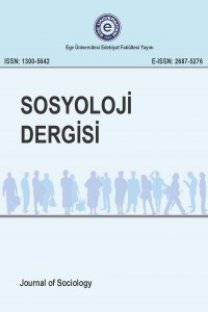HETERODOKSİ, TÜRK HALK İSLAMI VE EVLİYA KÜLTÜ*
Tinsellik insanın kendini kuşatan belirleyicilerden, fizyolojik, toplumsal, siyasal vb. her türlü sınırlayıcıdan kurtulma arayışına karşılık gelir. Bu anlamda tinsellik, biyolojik ve sonlu bir bedene sahip olan insanın özgürleşme, ölümsüzleşme ve kalıcılık istenci olarak da tanımlanabilir. Tin, sonlu hayatın sonsuzla yani kutsal olanla ilişkilendirilmesidir. Bu bağlamda tinselliğin en önemli kanalları büyü, mitos ve din olmaktadır. Büyü ve mitosa göre din, tinin kültürel, toplumsal ve siyasal bağlamlarda standartlaşması ve sınırlandırılması anlamına gelir. Din, tinselliği baskılar ancak buna rağmen, din içinde büyüsel, mitolojik bir söylem özellikle de halk yığınları nezdinde varlığını sürdürür. Bu durumu yansıtan kavramsallaştırma da halk dinidir. Bununla bağlantılı olarak bu çalışmanın temel amacı, Türk Toplumu özelinde İslam’da tinselliğin halk boyutunu tarihsel ve eşzamanlı analizler yoluyla ortaya koymaya çalışmaktır. Türk Halk İslamında kutsalla ilişki kurma biçimlerinin başında, velayet anlayışı ve velilik inancı ile bağlantılı bir biçimde yatır, türbe, mezar vb. kutsallık atfedilen mekânlar etrafında teşekkül eden inanç ve pratikler gelmektedir. Bu inanç ve pratikler, her ne kadar dini kurumlar ve makamlar tarafından yatsınsa da, halk imgeleminde anlam taşımaktadırlar. Genellikle maddi esenlikle ilişkilendirilen bu tür inanç ve pratikler, bilinçdışı düzeyde kutsala dokunmak, onun bereketinden yararlanmak anlamlarına gelir. Bu bağlamda çalışmada söz konusu inanç ve pratikler, veli kültü kavramı altında sınıflandırılmış ve çözümlenmeye çalışılmıştır
Anahtar Kelimeler:
Kutsal, Tinsellik, Heterodoksi Halk dini, Velâyet
Heterodoxy Turkish Folk Religion and Wali Cultus
Spirituality can be described as the search of mankind for emancipation from physiological and social determinants of life. In this context, it can be argued that, spiritualism is the will of man for permanence and infiniteness who is an impermanent and finite being. For this reason, spritualism links man to the the sacred which is infinite and omnipotent. This describes the relationship between spritualism, magic, myth and religion. Religion is the major channel for spritualism when compared to the others, but at the same time, religion delimits it and forces it to adapt to the cultural, social and political standarts. Religion supresses spiritualism, but in the end, spiritualism finds a gap through religious life. Namely mythological and magical aspects of religion correspond to the spiritualistic requirements in a society. The conceptualization folk religion, reflects this fact. In connection with this, the main aim of this work is to try to put forward the folk religious aspect of Islam and of Turkish society. The main way of getting in touch with the sacred in Turkish folk religion is the beliefs and practices occure around the tombs of saints or places related to the saints who are called as walis in Islamic terminology. Eventhough neglected by the religious officials, these beliefs and practices are common among the Turks’ religious imagery. Mostly identified with the material aspects of emancipation, these beliefs and practices connotes the possibility of touching the sacred and benefit from its baraka. In this context, in this work, these beliefs and practices are classified and analyzed through the concept of the wali cultus
Keywords:
Sacred Spritualism, Heterodoxy, Folk religion, Sainthood,
___
- LEUBA, James H., “The Varieties, Classification, and Origin of Magic”, American Anthropologist, New Series, Vol. 14, No. 2., American Anthropological Association, 1912, pp. 350-367.
- LÉVI-STRAUSS, Claude, Yaban Düşünce, Çev. Tahsin Yücel, Yapı Kredi Yayınları, İstanbul, 2000.
- TUCKER, Carlton H., “From the Axial Age to the New Age: Religion as a Dynamic of World History”, The History Teacher, Vol. 27, No. 4, Society for History Education, 1994, pp. 449-464.
- HODGSON, Marshall G. S., “The Interrelations of Societies in History”, Comparative Studies in Society and History, Vol. 5, No. 2, Cambridge University Press, Cambridge, 1963, pp. 227-250.
- GREEN, William A., “Periodizing World History”, History and Theory, Vol. 34, No. 2, Theme Issue 34: World Historians and Their Critics, Blackwell Publishing for Wesleyan University, 1995, pp. 99-111.
- ISSN: 1300-5642
- Yayın Aralığı: Yılda 2 Sayı
- Başlangıç: 1987
- Yayıncı: Ege Üniversitesi, Edebiyat Fakültesi
Sayıdaki Diğer Makaleler
HETERODOKSİ, TÜRK HALK İSLAMI VE EVLİYA KÜLTÜ*
JÜRGEN HABERMAS’IN YÖNTEM ANLAYIŞI
TELEVİZYON, TARİH VE TOPLUMSAL BELLEK
ANADOLU KENTLERİNİN ÖĞRENCİLEŞMESİ: BAŞKA BİR KENTLEŞME DENEYİMİ
Göknur EGE, Nicholas KOULLAPIS
KENTİÇİ BİR ÇÖKÜNTÜ ALANI ÖRNEĞİ KADİFEKALE’DE MEKAN SOSYOLOJİSİ DENEMESİ
GECEKONDUNUN KENTLE BÜTÜNLEŞME SÜRECİNDE ALAN-MEKÂN FAKTÖRÜ: İZMİR ÖRNEĞİ
